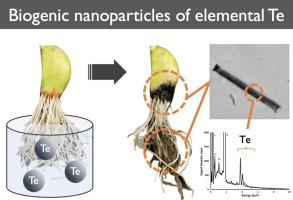Journal of Trace Elements in Medicine and Biology ( IF 3.6 ) Pub Date : 2020-07-23 , DOI: 10.1016/j.jtemb.2020.126628 Yu-Ki Tanaka 1 , Shohei Takada 1 , Kazuhiro Kumagai 2 , Keita Kobayashi 2 , Akiko Hokura 3 , Yasumitsu Ogra 1

|
Background
Biosynthesis of Te nanoparticles may occur in higher plants exposed to Te, as reported on microorganisms. However, unambiguous observations of the biogenic nanoparticles (BgNPs) of Te in plants are lacking. Hence, in this study, we investigated the formation of insoluble BgNPs of Te in garlic (Allium sativum) as a model plant.
Method
We performed elemental analysis based on inductively coupled plasma-mass spectrometry (ICP-MS) technique, and obtained Te concentration and distribution in various parts of garlic. In addition, insoluble Te particles were detected by fast time-resolved ICP-MS. Direct observation of the insoluble Te particle was also conducted by scanning electron microscope (SEM) and transmission electron microscope (TEM).
Results
A part of the roots and clove from Te-exposed garlic showed black coloration. Te concentrations in the black-colored parts were significantly increased compared with the non-colored parts. Transient signals of Te unique to nanoparticles were detected from the insoluble fractions of the black-colored parts. Finally, rod-shaped biogenic Te nanoparticles consisting of highly crystalline elemental Te was observed by SEM and TEM.
Conclusion
Our data provide new insights to the metabolic pathway of Te in higher plants for the formation of insoluble biogenic nanoparticles, which is extremely important for the detoxification of Te.
中文翻译:

通过电感耦合等离子体质谱法阐明大蒜中的碲生物纳米粒子。
背景
正如在微生物中报道的那样,Te 纳米颗粒的生物合成可能发生在暴露于 Te 的高等植物中。然而,缺乏对植物中 Te 的生物纳米粒子 (BgNPs) 的明确观察。因此,在这项研究中,我们研究了作为模式植物的大蒜(大蒜)中 Te 的不溶性 BgNPs 的形成。
方法
我们基于电感耦合等离子体质谱(ICP-MS)技术进行元素分析,获得了大蒜各部位Te的浓度和分布。此外,通过快速时间分辨 ICP-MS 检测到不溶性 Te 颗粒。不溶性Te颗粒的直接观察也通过扫描电子显微镜(SEM)和透射电子显微镜(TEM)进行。
结果
暴露于 Te 的大蒜的部分根和丁香呈黑色。与非彩色部分相比,黑色部分的 Te 浓度显着增加。从黑色部分的不溶部分检测到纳米颗粒特有的 Te 瞬态信号。最后,通过 SEM 和 TEM 观察到由高度结晶的元素 Te 组成的棒状生物 Te 纳米粒子。
结论
我们的数据为高等植物中 Te 的代谢途径提供了新的见解,以形成不溶性生物纳米颗粒,这对 Te 的解毒极为重要。











































 京公网安备 11010802027423号
京公网安备 11010802027423号